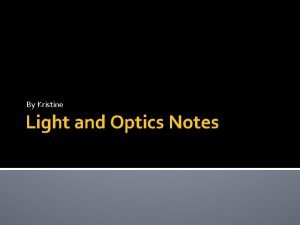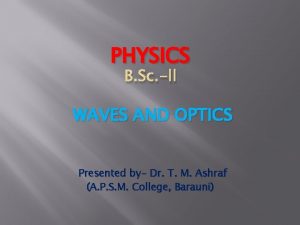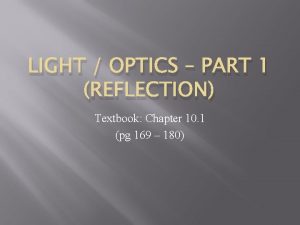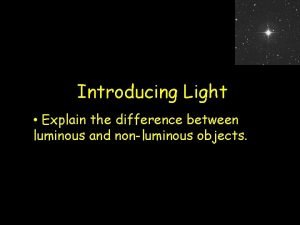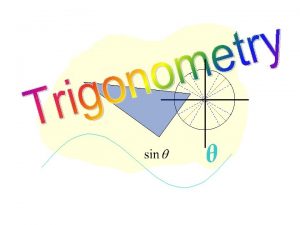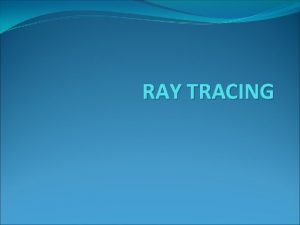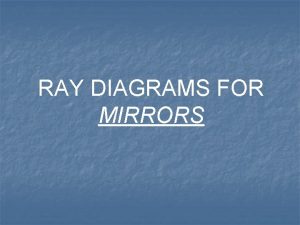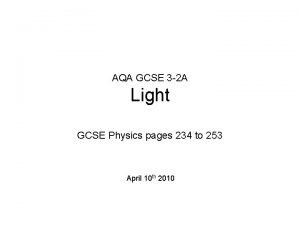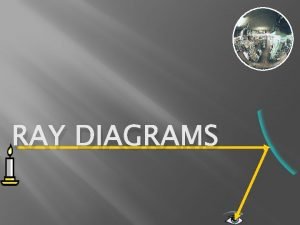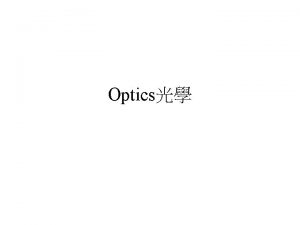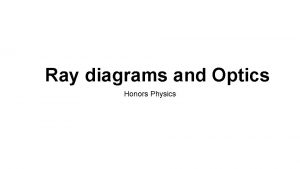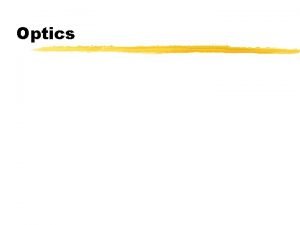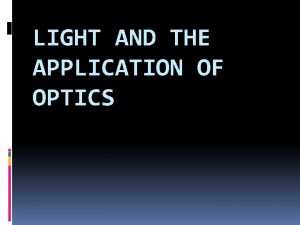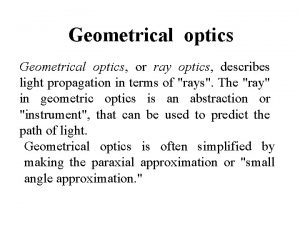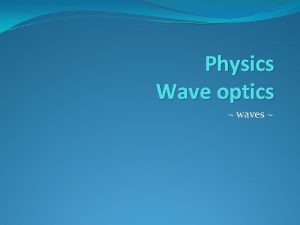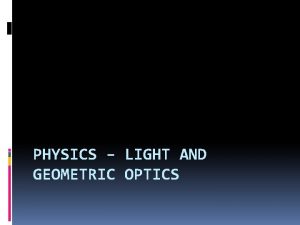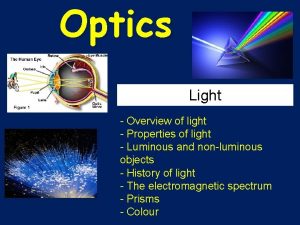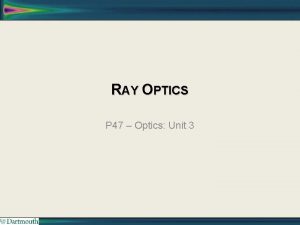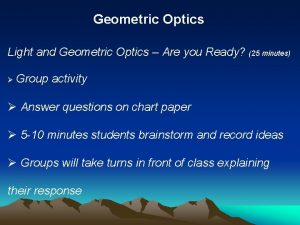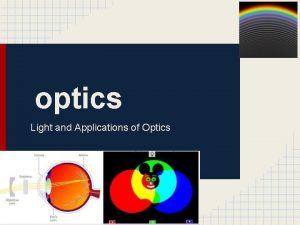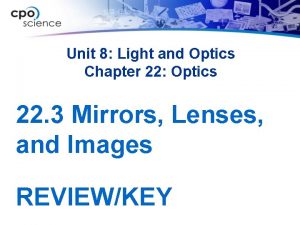Ray diagrams and Optics Physics Ray diagrams Light




















- Slides: 20

Ray diagrams and Optics Physics

Ray diagrams • Light travels in straight paths so we can draw rays • We will draw representative light rays that will show where an image forms based on how it reflects off a mirror (or refracts in a lens) • How light reflects (or refracts) depends on the curvature of the mirror or lens and the law of reflection (or snell’s law) • Center of curvature or radius of curvature (C) is 2 x the focal length (f) • Three light rays you can draw for mirrors: 1. A light ray coming in parallel to the axis will reflect through f 2. A light ray coming through f will reflect parallel 3. A light ray into the center of the mirror will reflect at the same incoming angle (law of reflection at the flat part of the mirror)

Concave mirror—object outside C A light ray coming in parallel to the axis will reflect through f C f A light ray coming through f will reflect parallel Light rays intersect, so this is a real image. Image is smaller, upside down, between C & f

Same example using equations f=focal length di= image distance do= object distance Magnification - the number of times larger an object appears as seen by the naked eye (negative means upside down, less than 1 is smaller and greater than 1 is larger) M = -di = hi do ho Example: A candle is placed in front of a concave mirror with a focal length of 10 cm. The candle is 40 cm away from the mirror. Where will the image form? M = -di = - 13. 3 cm = -0. 333 do 40 cm

Concave mirror—object at C A light ray coming in parallel to the axis will reflect through f C f A light ray coming through f will reflect parallel Light rays intersect, so this is a real image. Image is same size, upside down, at C

Concave mirror—object between C & f A light ray coming in parallel to the axis will reflect through f C f A light ray coming through f will reflect parallel Light rays intersect, so this is a real image. Image is larger, upside down, outside C

Concave mirror—object at f A light ray coming in parallel to the axis will reflect through f C f A light ray into the center of the mirror will reflect at the same incoming angle Light rays are parallel, so there is NO IMAGE formed.

Concave mirror—object inside f A light ray coming in parallel to the axis will reflect through f Light rays intersect behind mirror, so this is a VIRTUAL image. Image is larger, right side up, and appears inside mirror. C f A light ray into the center of the mirror will reflect at the same incoming angle

Convex Mirror A light ray coming into center will reflect at same angle Light rays intersect behind the mirror, so this always forms VIRTUAL images. Image is smaller, right side up, and appears inside the mirror. Uses: bus mirrors, passenger side view mirror, surveillance mirrors in stores

Ray diagrams for lenses • Light travels in straight paths so we can draw rays • We will draw representative light rays that will show where an image forms based on how it refracts in a lens • How light refracts depends on the curvature of the lens and snell’s law • Center of curvature or radius of curvature (C) is 2 x the focal length (f) • Three light rays you can draw for lenses: 1. A light ray coming in parallel to the axis will refract through f 2. A light ray coming through f will refract parallel 3. A light ray into the center of the lens will pass straight through the lens

Convex lens—object outside C A light ray coming in parallel to the axis will refract through f C f f A light ray coming through f will refract parallel Light rays intersect, so this is a real image. Image is smaller, upside down, between C & f C

Same example using equations f=focal length di= image distance do= object distance Magnification - the number of times larger an object appears as seen by the naked eye (negative means upside down, less than 1 is smaller and greater than 1 is larger) M = -di = hi do ho Example: A candle is placed in front of a convex lens with a focal length of 8 cm. The candle is 40 cm away from the lens. Where will the image form? M = -di = - 10 cm = -0. 25 (-) means upside down 0. 5 x as big do 40 cm

Convex lens—object at C A light ray coming in parallel to the axis will refract through f C f A light ray coming through f will refract parallel Light rays intersect, so this is a real image. Image is same size, upside down, at C f C

Convex lens—object between C & f A light ray coming in parallel to the axis will refract through f C f A light ray coming through f will refract parallel Light rays intersect, so this is a real image. Image is larger, upside down, outside C f C

Convex lens—object at f A light ray coming in parallel to the axis will refract through f C f f A light ray going through center of lens goes straight through Light rays are parallel, so there is NO IMAGE formed. C

Convex lens—object inside f A light ray coming in parallel to the axis will refract through f C f f A light ray going through center of lens goes straight through Light rays trace back inside lens so this is a VIRTUAL image. Image is larger, right side up, inside lens. (This is a magnifying glass. Something is magnified only when held inside f. ) C

Same example using equations f=focal length di= image distance do= object distance Magnification - the number of times larger an object appears as seen by the naked eye (negative means upside down, less than 1 is smaller and greater than 1 is larger) M = -di = hi do ho Example: A candle is placed in front of a convex lens with a focal length of 10 cm. The candle is 5 cm away from the lens. Where will the image form? (-) means VIRTUAL M = -di = do - (- 10 cm ) = 2 cm +5 (+) means right side up 5 x as big

Concave lens (diverging lens) A light ray coming in parallel to the axis will diverge A light ray going through center of lens goes straight through Light rays trace back inside lens so this is a VIRTUAL image. Image is smaller, right side up, inside lens. (A concave lens always makes images smaller and virtual. )

How your eye works Your eye has a convex lens of your eye focuses a real, smaller, upside down image on the back of your retina. Your brain flips the image right side up.

Near sighted vs. Far sighted (corrected with diverging lens Focus is NOT on the retina vs. corrected with converging lens) Corrected vision with lenses
 Difference between ray optics and wave optics
Difference between ray optics and wave optics Reflection and refraction venn diagram
Reflection and refraction venn diagram Light and optics notes
Light and optics notes Bill nye reflection and refraction
Bill nye reflection and refraction Wave optics b.sc physics
Wave optics b.sc physics Bill nye reflection and refraction
Bill nye reflection and refraction Difference between luminous and non luminous object
Difference between luminous and non luminous object Light light light chapter 23
Light light light chapter 23 Into the light chapter 22
Into the light chapter 22 Light light light chapter 22
Light light light chapter 22 Use case model
Use case model An activity diagram is a static model.
An activity diagram is a static model. Tan 30
Tan 30 Ray tracing and ray casting
Ray tracing and ray casting Ray diagrams for concave mirrors
Ray diagrams for concave mirrors Ray diagram bbc bitesize
Ray diagram bbc bitesize Diverging lens concave
Diverging lens concave Concave lens ray diagram
Concave lens ray diagram Purdue phys 241
Purdue phys 241 Disadvantages of fibre optic cable
Disadvantages of fibre optic cable Sankey diagram for one bounce of a ball answers
Sankey diagram for one bounce of a ball answers


